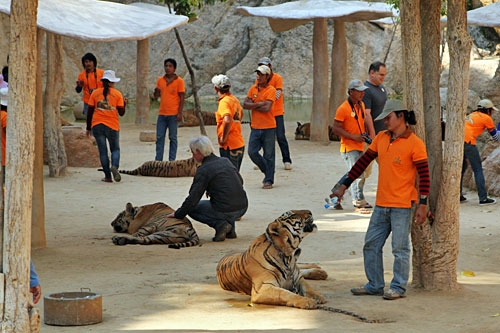As our tour bus drew nearer the Tiger Temple, our guide briefed us on the do’s and dont’s of interacting with the big cats.
“Any necklaces must be removed. Red clothing aggravates the tigers so it is not allowed, and because you are visiting a Buddhist monastery, out of respect for the monks who operate the sanctuary, your clothing must cover your upper arms and knees. And absolutely no sunglasses are allowed!”
“What about regular glasses?”I asked, since I don’t see well without mine.
He assured me that regular glasses were OK, explaining that the tigers see themselves reflected in the mirrored surface of sunglasses and, thinking it is another cat, they attack or swipe playfully. Despite his assurances, I walked the searing, rock-strewn path to the abandoned quarry with trepidation but I had come to Kanchanaburi province in Thailand to pet tigers and nothing was going to stop me.
In 1999, residents of the province just west of Bangkok found an abandoned tiger cub. Speculating that poachers had killed the mother, they brought the baby to the monks at Wat Pha Luang Ta Bua Buddhist temple that had been opened five years earlier as a forest temple and sanctuary for wild animals. That first cub died, but two more quickly followed, along with a bear, deer, camel, and water buffalo, among a variety of other animals. Gradually the menagerie grew and by the time I visited in March 2011, the temple was caring for 49 tigers.

Each day a number of the resident tigers are led to an on-site quarry, where they lie in the shade as tourists are led around the enclosure and allowed to pet them. I stood in line, listening to the cautions of the volunteers and staff who work at the Tiger Temple. We could not take any cameras or bags into the quarry. Jackets must be removed. And we must completely obey the guides who would lead us around by the hand and instruct us where to kneel and what to do with each tiger. As they ticked through their list, I counted a dozen tigers scattered around the compound. Each lay beneath a beach umbrella for shade in the mid-afternoon heat, secured by a single length of chain attached to neck collars. Some dozed while others rolled playfully on their backs, sending billows of ocher dust into the air. Every so often one of the tigers would raise its head and open its mouth, a sign for a volunteer to squirt a stream water from a squeeze bottle into its mouth.
Before long it was my turn. One guide commandeered my camera while the other slowly led me by the hand past the first tiger, motioned for me to kneel behind it, and demonstrated where I should pet it. Tentatively, I reached out and stroked the haunches of the magnificent feline. Acutely aware that it could take me out with one swipe of a deadly paw, I flinched when the tiger twitched and quickly drew my hand away, but the allure of actually petting a wild tiger was too powerful and I reached back to stroke the soft, sleek fur. Around the old quarry I circuited, sometimes kneeling, sometimes squatting next to cats, at one point even reclining between two cats perched on boulders, entranced but never letting down my guard for an instant.
Although one animal rights organization has charged that “animal welfare problems at the Tiger Temple are severe and include poor accommodation, lack of appropriate environments and veterinary care, and physical abuse of the tigers to make them compliant for visiting tourists,” I saw absolutely no evidence of this. The tigers seemed content to allow human interaction and I didn’t feel they were drugged; they moved lazily but no differently than tigers I have seen during the heat of the day in zoos all over the world and they are rotated so that no one cat is forced to engage with humans on a daily basis. Outside of the quarry, in a new enclosure, staff members waded in the moat with other tigers, playing tug-o-war with a toy attached to a broom handle. When the game was over the employees turned their backs and walked away, stopping every few feet to turn around and chastise one of the cats that followed, ordering it to sit. Astonishingly, the tiger complied.
Since it costs approximately $100 per day to feed each tiger, monks at the Tiger Temple solicit volunteers to work on site. Volunteers must be willing to donate a minimum of two weeks, work six days a week, and attend daily meditation ceremonies with the monks. Room and board is provided and a stipend of 700 Baht (about $24 US) is paid to each volunteer on his or her day off, in the event that they wish to spend a night in the nearby town. For more information on volunteering, refer to the Tiger Temple volunteer information page.

In the late afternoon, just before our group was scheduled to leave, I happened upon a small pavilion where another cub lounged. At four months old it was the size of a medium size dog and not nearly as intimidating as the mature tigers. Crouching down, I stroked its back and scratched its head and ears. I swear it purred.

Thanks for the great read. Keep it up!
I too could feel the tension from the photos but the video truly showed how intimidating the tigers looked. I think I’ve also seen on documentaries where tigers purr, it’s got to be a good feeling to know they’re happy when you’re so close 🙂 Both for the experience and well, for the comfort of knowing a tiger isn’t in a bad mood!
Barbara, we’ve petted tigers in Thailand, and it’s an amazing experience. What I learned from someone who had volunteered at the place we did it, Tiger Kingdom, however, is that it is not generally drugging that is involved to keep them under control, but physical chastisement (squeezing adult males’ testicles, for example). There’s also a suggestion that many adult tigers end up in Chinese medicine products.
Hi Theodora: That’s truly disgusting. I did a bit of research on the Tiger Temple and read that one animal rights group accused the temple of illegal trafficking of protected animals. The Thai government subsequently investigated and found absolutely no evidence if such activity, nor of any other improper behavior such as abuse. I also spoke to a couple of volunteers who had been there long term and asked those tough questions and they both insisted that the tigers were alll treated with nothing but love. Even the report in Wikipedia, where I found the report of illegal trafficking, noted that the animal rights group was unheard of prior to making this charge, implying that they did it for political and self-serving reasons. So I was left to decide for myself and when I viewed the interaction between the staff/volunteers and the tigers in the tiger island enclosure (shown in my video) I decided that the tigers are well treated. My guess is that animals cared for by monks are much better treated than those in a commercial operation created for the express purpose of making a profit. At least I hope so.
Hi Barbara
I was the one of the main undercover investigators for this report you refer to. You may also wish to purchase the upcoming book Behind the Cloak of Buddha to find out the facts.
I’m wondering why the link was disabled, I find this rather odd I just copied the link & went there myself. I believe all is not as wonderful as you claim, barbara.
Hi Daestep: I just tried and was able to access the site, although it is
very slow. I suspect they are having host/server problems; happens to the
best of us, even my site is down on occasion.
This article made me think of something my friend shared with me the other day. She was recently in South Africa for a semester and was discussing how she was somewhat behind in comparison to the other students because living in such a place they knew so much about certain animals and insects that she had never heard of. They almost judged her for not having the same level of knowledge about these regional species. Reading your article about how much knowledge these individuals have about tigers, about how to take precaution in the correct ways, etc, just reminded me of the intimacy of knowledge from different parts of the world. And this is exactly why travel is such an amazing thing – bridging gaps in knowledge and understanding across borders!
Hi Melanie: Thanks for that thought. It made me think about how disconnected
we are from the natural world in developing countries. We could take a huge
lesson from those who live closer to the land.
Fascinating that their fur is more like a regular cat’s, silky smooth. I got to pat an African lion cub many years ago, and its fur felt more like a brillo pad. It surprised me.
Great experience, Barbara. Kathy and I did this several years ago. They didn’t have the umbrellas in the canyon and they were just beginning work on the new enclosure. I agree with you. Even back then, we saw no evidence of mistreatment or lack of proper care and, certainly, no drugging of the animals. I hope Kathy doesn’t read the part about volunteering…I’m afraid she will insist that we go back so we can do that. Might be fun though. She also wanted to volunteer at the Elephant habitat in Chiang Mai. 🙂
Travel well.
Chuck
Hi Chuck: So glad your experience was similar. The tigers seem so willing to
interact with humans. Did you see the part in the video where the volunteer
swats the tiger on the nose to discipline it, and then later walks away from
it and, when it lopes after her, she turns around and makes it stay. My jaw
dropped. I think you should go do it! Volunteer, that is.
What an absolutely awesome (in the true sense of the word, not as in the over-used modern sense!) experience. I’m sending this right on to my son, who has always been crazy about tigers since he was small! Apropros the sunglasses thing – my brother-in-law uses a motorized scooter when here on vacation, and was attacked by a peacock who saw his reflection in it!
This was a great post! I really enjoyed reading about you being able to pet the tigers!! Yikes that must have been scary.
I had to chuckle when you were telling about not being able to wear sunglasses because the tigers see the reflection and think its another tiger. I have seen turkey’s chasing cars for the same reason. They see themselves in the chrome bumpers!
So Awesome! Love the video.
Good heavens. I knew there was a reason I don’t wear sunglasses! Thanks all.
Wow, what an experience!!! They are such gorgeous creatures.
Yeah, but more than a little intimidating!